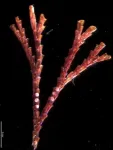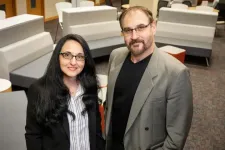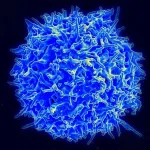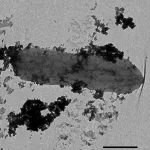(Press-News.org) Scientists from Russia, Austria, and the USA have discovered virus-like particles in the bacterial symbionts of Bryozoa - a phylum of colonial aquatic invertebrates - filter-feeders dominating in many bottom ecosystems. The research project was planned and supervised by scientists from St Petersburg University. Some of the virus-like particles resemble red blood cells, while others have a sea-urchin-like appearance. Although viruses have never been reported inside symbiotic bacteria in bryozoans, scientists suggest that this "matryoshka doll" may have a prominent effect on the bacterial hosts.
Life of most organisms on our planet is closely associated with bacterial communities - microbiota that plays a very important role in the health of the host from helping to control digestion to protection of the host from infections. Bryozoa are not an exception. Inside some of these invertebrates the symbiotic bacteria live that, e.g. make larvae not eatable for fish. Yet how the symbiosis can benefit the host itself still remains a mystery. Scientists from the St Petersburg University tried to solve it and eventually made an unexpected discovery.
They encountered the virus-like particles in the colonies of the cheilostome bryozoan Bugula neritina that were intertidally collected from the east coastal area of the USA, and in Paralicornia sinuosa that was collected near Australia. Between bacteria of B. neritina the virus-like particles were found that resembled red blood cells. The particles found inside and between bacteria of P. sinuosa were reminiscent the sea urchins. These were spherical and consisting of cylindrical/tube-like elements evenly radiating from the central double-walled 'core'. To gain a better understanding of what the particles are and what role they play in the life of moss animals the biologists from the University established a collaboration with experts from the Winogradsky Institute of Microbiology, the Russian Academy of Sciences.
'So-called "urchins" from the Australian bryozoan is much alike the "metamorphosis associated contractile structures (MACs)" described by the American scientists in 2014. These structures can be found inside the biofilm-forming marine bacteria Pseudoalteromonas luteoviolacea. MACs have the same origin as the viruses-bacteriophages. In fact, ???s are an assemblage of multiple contractile systems related to the contractile tails of myoviruses (tailed bacteriophages with contractile tails). Contacting the biofilms of Pseudoalteromonas can induce larval metamorphosis in the tubeworm Hydroides elegans. When settling, the larvae of H. elegans contact the biofilm at sea bottom, and the "urchins"' inside the biofilm inject a protein signal into the cells of the larvae. The delivery of the protein induces larval metamorphosis,' said Professor Andrey Letarov, Head of the Laboratory of Microbial Viruses at the Winogradsky Institute of Microbiology, RAS.
Yet there are some differences, Dr Letarov explained. The 'urchins' inside the bacteria that were studied by the Americans are very large and not 'well-organized', while the particles inside the bacteria of Paralicornia sinuosa are finely structured into tiny spheres. But generally speaking, there is much in common between these structures. What role the 'urchins' play in this biological system remains unclear. Yet there is some tentative evidence.
'We know that in some bryozoan species, in particular in Bugula neritina, bacteria from maternal tissues are transmitted to larvae thus providing the vertical transfer of the symbionts between bryozoan generations. Viruses should be transmitted together with bacteria. Yet not all of the bacteria are moved into the larvae. Those that remain in the host can multiply producing an excess of toxic metabolites. This can pose a potential threat to the host. Presumably, the newly discovered viruses can destroy these bacteria thus regulating the symbiont number in the bryozoan hosts,' said END
Scientists from St. Petersburg University discovered the virus-like particles in Bryozoa
Although viruses have never been reported inside symbiotic bacteria in bryozoans, scientists suggest that this 'matryoshka doll' may have a prominent effect on the bacterial hosts
2021-01-08
ELSE PRESS RELEASES FROM THIS DATE:
Measuring racial inequities in COVID-19 testing
2021-01-08
What The Study Did: This study adapted a well-established tool for measuring inequity from economics--the Lorenz curve--to measure racial inequities in COVID-19 testing.
Author: Aaloke Mody, M.D., of the Washington University School of Medicine in St Louis, is the corresponding author.
To access the embargoed study: Visit our For The Media website at this link https://media.jamanetwork.com/
(doi:10.1001/jamanetworkopen.2020.32696)
Editor's Note: The article includes funding/support disclosures. Please see the article for additional information, including other authors, author contributions and affiliations, conflict of interest and financial disclosures, and funding and support.
INFORMATION:
Media ...
Study: Religion, psychology share methods for reducing distress
2021-01-08
CHAMPAIGN, Ill. -- Religious people facing life crises rely on emotion-regulation strategies that psychologists also use, a new study finds. They look for positive ways of thinking about hardship, a practice known to psychologists as "cognitive reappraisal." They also tend to have confidence in their ability to cope with difficulty, a trait called "coping self-efficacy." Both have been shown to reduce symptoms of anxiety and depression.
The new findings are reported in the Journal of Religion and Health.
"It appears that religious people are making use of some of the same tools that psychologists have systematically identified as effective in ...
Ferroptosis resistance in cancer: An emerging crisis of new hope
2021-01-08
Announcing a new publication for BIO Integration journal. In this opinion article the authors Daiyun Xu, Yonghui Lü, Yongxiao Li, Shengbin Li, Zhe Wang and Junqing Wang from Sun Yat-Sen University, Guangzhou, China discuss ferroptosis resistance in cancer.
Ferroptosis is a lethal consequence of accumulated lipid peroxidation catalyzed by ferrous iron and oxygen. This unique cell death process appears to involve many diseases, such as neurodegeneration, ischemia/ reperfusion injury, kidney disease, and a druggable target in therapy-resistant cancers. Ferroptosis may provide hope for ...
We hear what we expect to hear
2021-01-08
Humans depend on their senses to perceive the world, themselves and each other. Despite senses being the only window to the outside world, people do rarely question how faithfully they represent the external physical reality. During the last 20 years, neuroscience research has revealed that the cerebral cortex constantly generates predictions on what will happen next, and that neurons in charge of sensory processing only encode the difference between our predictions and the actual reality.
A team of neuroscientists of TU Dresden headed by Prof Dr Katharina von Kriegstein presents new findings that show that not only the cerebral cortex, but ...
Researchers realize efficient generation of high-dimensional quantum teleportation
2021-01-08
In a study published in Physical Review Letters, the team led by academician GUO Guangcan from University of Science and Technology of China (USTC) of the Chinese Academy of Sciences (CAS) made progress in high dimensional quantum teleportation. The researchers demonstrated the teleportation of high-dimensional states in a three-dimensional six-photon system.
To transmit unknown quantum states from one location to another, quantum teleportation is one of the key technologies to realize the long-distance transmission.
Compared with two-dimensional ...
USTC develops ultrahigh-performance plasmonic metal-oxide materials
2021-01-08
In a study published in Advanced Materials, the researchers from Hefei National Laboratory for Physical Sciences at the Microscale, the University of Science and Technology of China of the Chinese Academy of Sciences, using an electron-proton co-doping strategy, invented a new metal-like semiconductor material with excellent plasmonic resonance performance. This material achieves a metal-like ultrahigh free-carrier concentration that leads to strong and tunable plasmonic field.
Plasmonic materials are widely used in the fields including microscopy, sensing, optical computing and photovoltaics. Most common plasmonic materials are gold and silver. Some other materials ...
Understanding how to improve antibodies targeting OX40 for the treatment of cancer
2021-01-08
Scientists at the University of Southampton's Centre for Cancer Immunology have gained new insight into how the immune system can be better used to find and kill cancer cells.
Working with BioInvent International, a team led by Professor Mark Cragg and Dr Jane Willoughby from the Antibody and Vaccine Group, based at the Centre, have shown that antibodies, designed to target the molecule OX40, give a more active immune response when they bind closer to the cell membrane and can be modified to attack cancer in different ways.
OX40 is a 'co-receptor' that helps to stimulate the production of helper and killer T-cells during an immune ...
How 'Iron Man' bacteria could help protect the environment
2021-01-08
When Michigan State University's Gemma Reguera first proposed her new research project to the National Science Foundation, one grant reviewer responded that the idea was not "environmentally relevant."
As other reviewers and the program manager didn't share this sentiment, NSF funded the proposal. And, now, Reguera's team has shown that microbes are capable of an incredible feat that could help reclaim a valuable natural resource and soak up toxic pollutants.
"The lesson is that we really need to think outside the box, especially in biology. We just know the tip of the iceberg. Microbes have been on earth for billions of years, and to think that they can't do something precludes us from so many ideas and applications," said Reguera, a professor in ...
Possible explanation for more efficient maize growth
2021-01-08
Maize has a significantly higher productivity rate compared with many other crops. The particular leaf anatomy and special form of photosynthesis (referred to as 'C4') developed during its evolution allow maize to grow considerably faster than comparable plants. As a result, maize needs more efficient transport strategies to distribute the photoassimilates produced during photosynthesis throughout the plant.
Researchers at HHU have now discovered a phloem loading mechanism that has not been described before - the bundle sheath surrounding the vasculature as the place for the actual transport of compounds such as sugars or amino acids. The development of this mechanism could have been ...
Autism theory 25 years in the making
2021-01-08
A unifying explanation of the cause of autism and the reason for its rising prevalence has eluded scientists for decades, but a theoretical model published in the journal Medical Hypotheses describes the cause as a combination of socially valued traits, common in autism, and any number of co-occurring disabilities.
T.A. Meridian McDonald, PhD, a research instructor in Neurology at Vanderbilt University Medical Center, has spent 25 years researching autism, from a time she could read literally every research paper on the topic in the 1990s until now, when there is an overload of such studies.
"Up until now there have been a lot of theories about the possible causes ...
LAST 30 PRESS RELEASES:
House sparrows in northern Norway can help us save other endangered animals
Crohn's & Colitis Foundation survey reveals more than 1/3 of young adults with IBD face step therapy insurance barriers
Tethered UAV autonomous knotting on environmental structures for transport
Decentralized social media platforms unlock authentic consumer feedback
American Pediatric Society announces Vanderbilt University School of Medicine as host institution for APS Howland Visiting Professor Program
Scientists discover first method to safely back up quantum information
A role for orange pigments in birds and human redheads
Pathways to net-zero greenhouse gas emissions for Southeast Asia
A JBNU–KIMS collaborative study on a cost-effective alloy matches superalloys for power plants and energy infrastructure
New study overturns long-held model of how plants coordinate immune responses.
New AI model predicts disease risk while you sleep
Scientists discover molecular ‘reshuffle’ and crack an 80-year-old conundrum
How stressors during pregnancy impact the developing fetal brain
Electrons lag behind the nucleus
From fungi to brain cells: one scientist's winding path reveals how epigenomics shapes neural destiny
Schizophrenia and osteoporosis share 195 genetic loci, highlighting unexpected biological bridges between brain and bone
Schizophrenia-linked genetic variant renders key brain receptor completely unresponsive to both natural and therapeutic compounds
Innovative review reveals overlooked complexity in cellular energy sensor's dual roles in Alzheimer's disease
Autism research reframed: Why heterogeneity is the data, not the noise
Brazil's genetic treasure trove: supercentenarians reveal secrets of extreme human longevity
The (metabolic) cost of life
CFRI special issue call for papers: New Frontiers in Sustainable Finance
HKU Engineering scholar demonstrates the smallest all-printed infrared photodetectors to date
Precision empowerment for brain "eavesdropping": CAS team develops triple-electrode integrated functional electrode for simultaneous monitoring of neural signals and chemical transmitters during sleep
Single-capillary endothelial dysfunction resolved by optoacoustic mesoscopy
HKU three research projects named among ‘Top 10 Innovation & Technology News in Hong Kong 2025’ showcasing excellence in research and technology transfer
NLRSeek: A reannotation-based pipeline for mining missing NLR genes in sequenced genomes
A strand and whole genome duplication–aware collinear gene identification tool
Light storage in light cages: A revolutionary approach to on-chip quantum memories
Point spread function decoupling in computational fluorescence microscopy
[Press-News.org] Scientists from St. Petersburg University discovered the virus-like particles in BryozoaAlthough viruses have never been reported inside symbiotic bacteria in bryozoans, scientists suggest that this 'matryoshka doll' may have a prominent effect on the bacterial hosts






